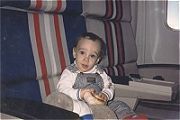Does flying with baby sound like a daunting task? Here are tried and true strategies – plus some empowering advice – to make it breezy.
The excitement, chaos, fatigue, fear and joy that arrive with each new child make parents understandably reluctant about planning their first flight with Baby-On-Board. But your grandparents and in-laws, who grew up in an era when Moms clutched swaddled infants in the car’s front seat, won’t accept the “Baby’s too young to fly!” excuse for long. Soon enough (even before the umbilical chord falls off for some), you and that teeny thing will be airborne!
Tips to Make It Affordable:
1) Buy An Infant Seat. For domestic US travel, one infant under 2 years may travel free with each fare-paying adult as a “lap child.” To encourage seat purchases for infants, the major US airlines now charge only 50% of the lowest ticketed adult fare for children under 2. On international flights, most airlines charge 10% for a lap child, and from 50%-65% of the adult fare for a reserved seat for children 2-12 years.
2) Use A Professional. Inform your travel agent of all children flying with you and their ages, and let him/her get you the best fares and seats.
3) Think Global. Always investigate the children’s fare (typically ages 2-11) on foreign airlines serving your destination. Many savvy families choose “international” destinations such as Mexico or the Caribbean for a vacation, then use the national carrier rather than a US airline, to save on children’s airfares.
4) Look for Good Value. Frequent flyer awards are not discounted for children, so if you’re flying with free miles, you may be better off paying cash for their seats. If you’re nervous about booking a low-cost airline, check with your travel agent or www.faa.gov for the airline’s safety record.
Tips to Make It Bearable:
5) Avoid the Rush Hour. A flight spanning your child’s naptime is ideal, if you can avoid the early morning and late-day business commuter flights. If you’re crossing several time zones, overnight flights can help a child who sleeps well acclimate to the time change and reduce jet lag.
6) Use a Car Seat/CRS. The FAA encourages all children up to 40 lbs. to travel in a child restraint system (CRS) no wider than 16″ and labeled “certified for use in aircraft.” It will protect your child in case of a high-impact crash from the airplane seat, which is designed to crumple forward. Though we’ve seen inflatable flight seats, harnesses, and lots of other gadgets, nothing has been approved by the FAA other than several regulation car seats. Call them at 800/FAA-SURE with any questions about your model.
7) Strategies with a Lap Child. If you’re traveling in economy class with your infant as a lap child, request a bulkhead seat and a bassinette, provided free of charge by most airlines on wide body aircraft. If you can afford first class with your infant, bring a blanket or carry-mat because she will be very cozy on the floor in front of your feet. If you’re traveling with a child over about 6 months or 24″ long, choose economy class but avoid the bulkhead. In this row, the armrests are fixed, and your infant will not be able to sleep straddling seats if adjoining ones are vacant. Also note that some newer plane models have turned bulkhead rows into Emergency Exit rows, which are restricted to over-16s for safety reasons.
8) Get Seat Assignments Early. Insist on prebooking at least one window or aisle seat for someone in your party. No one else wants to sit alone with your infant and they’ll be happy to trade!
Any comments on the techniques discussed in this video from TravelVideoPostcard.com
Tips to Make It Safe and Healthy:
9) Lighten Your Load. Use curbside luggage check-in wherever available so you won’t have to find a porter. Minimize hand luggage and try to use a front carrier or backpack for your child so you can maneuver plane tickets, passport, and other papers.
10) Airport Security. Security Checkpoints now insist that your infant be removed from carrier or stroller, and carried through X-ray setups by an adult. (Stay alert! My toddler ran away and onto Toronto’s moving sidewalk while I was being searched.) Most airlines will gate-check your stroller on the Jetway so you can pick it up immediately upon landing.
10) Feed Your Baby Inflight. Nursing Moms will have an easy go of it; nursing Dads should carry a freezer pack with a few extra bottles that the Flight Attendant can warm. Be sure to bring some refillable bottles or “tippy” cups for juice or water. (Open them carefully, as the change in air pressure turns some models into absolute geysers.) Order children’s meals in advance, and bring some beverages and snacks in case you’re on a peanuts-only flight or experience long delays. As for dining yourself or enjoying that Starbucks coffee, forget it unless the adults in your party outnumber the kids.
11) Change Diapers Often. Carry a small blanket or changing mat so that a urine-filled diaper can be changed in an empty row of seats (do this discreetly or some passengers will go crazy). If you must use the lavatory, urge your spouse to come with you, pry the door open with your body, have them lower the diaper changing table (available on a few aircraft) and hold it, and then change diapers with as few sudden moves as possible. With newborns, the toilet seat lid is an easier, less wobbly place to perfect this technique.
12) Bring a Change of Clothes. Take at least one change for each adult and child. I’ll never forget greeting my in-laws at the arrival gate after my 6-month-old had thrown puréed beets (his favorite food) all over me, himself and his Dad. We looked like extras from the set of Texas Chainsaw Massacre.
13) Prevent Ear Aches. To prevent pain associated with air pressure changes that affect the middle ear chamber, Dr. Neal M. Kotin, FTF’s own Doc Holiday, suggests, “Be sure your child swallows (infants can be nursed or bottle-fed) during ascent and, more importantly, during descent.” If your child has a history of ear pain, wake her up to nurse/swallow during take-off and landing.
14) How to Induce Sleep. Imitating nightly rituals, such as changing into pajamas and sharing a book or a song, works for many children. Some parents use Tylenol, over-the-counter decongestants, and other gentle drugs (such as sweetened chamomile tea, homeopathic teething pain relievers, or Gripe Water) to sedate their kids or induce sleep on very long plane flights. Consult a pediatrician before administering any medication to an infant.
15) Get Exercise. If you have a lap child, strolls are essential to avoid gangrene. Be kind to Flight Attendants by avoiding beverage and meal service times. Plan your aisle visits mid-flight, when air turbulence (always unpredictable!) is least likely to occur.
Tips to Make It Fun:
16) Be Considerate! Flying with a child is a full time job. Your planemates (especially those who were never children themselves) will expect you to remain alert. Don’t forget quiet cuddlies, toys, books and projects to work on.
17) Act Up! Using the instruction card in your seat pocket, act out the plane’s emergency exit procedures.
18) Get Creative! Review your SkyMall catalogue for pet gift items, show the photos to your child, and teach her the sounds each animal makes.
19) Be Inventive! Decorate your airsickness bag and use it as a hand puppet. Play peek-a-boo with a blanket.
20) No Matter What Your Child Does, Be Proud! Suction that “Baby-On-Board” sign to your aircraft window. Go on — from now on, you can display it proudly on all your travels.
Dear Reader: This page may contain affiliate links which may earn a commission if you click through and make a purchase. Our independent journalism is not influenced by any advertiser or commercial initiative unless it is clearly marked as sponsored content. As travel products change, please be sure to reconfirm all details and stay up to date with current events to ensure a safe and successful trip.

